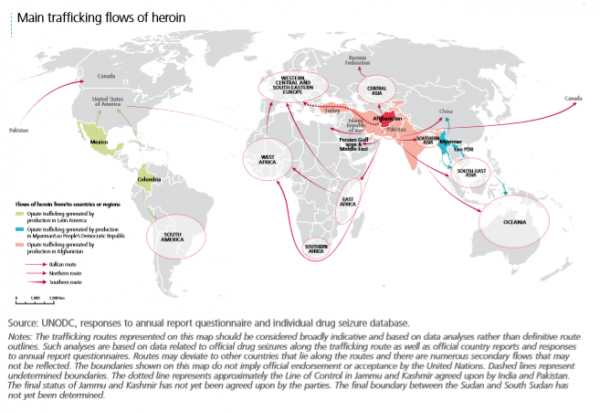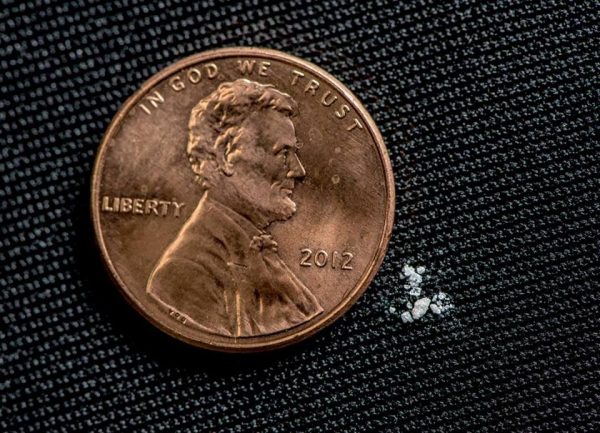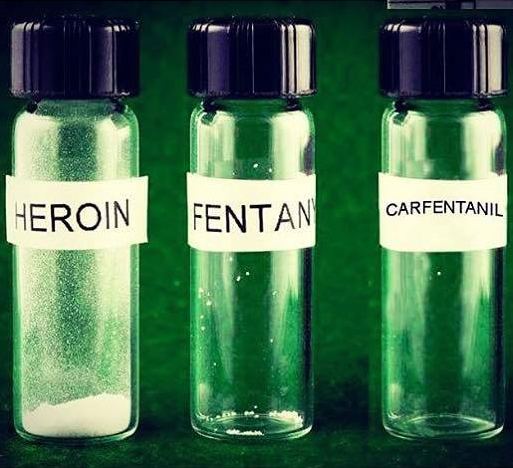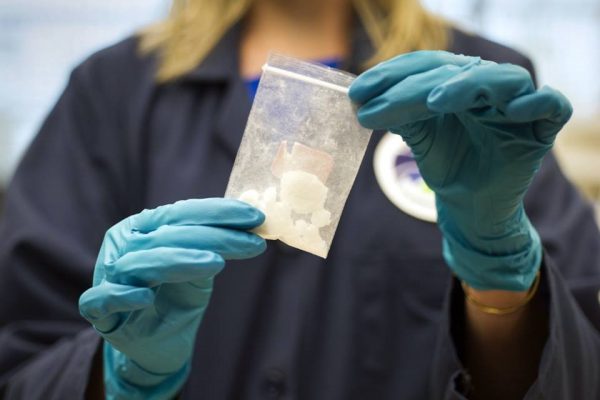For those of you who have been following me for any length of time, you may remember that I wrote an article on the real reason why we invaded Afghanistan. And that reason was for the control of the opium trade.
In short, according to Global Research, the “Golden Crescent” trade in opiates constitutes, at present, the centerpiece of Afghanistan’s export economy. The heroin trade, instated at the outset of the Soviet-Afghan War in 1979 and protected by the CIA, generates cash earnings in Western markets in excess of $200 billion a year.
Since the 2001 invasion, narcotics production in Afghanistan has increased more than 35 times. In 2009 alone, opium production stood at 6900 tons. To put that in perspective, opium production was less than 200 tons in 2001.
That amount of opium has to be going somewhere…and now, lo and behold, we have an opioid crisis in America of epic proportions.

According to US News, in November, the White House’s Council of Economic Advisers also released a report claiming that previous estimates of the economic cost of the epidemic “greatly understate” the true value lost. They estimated that the opioid crisis cost the country $504 billion, equivalent to 2.8 percent of the year’s GDP, in 2015.
The numbers are staggering. Opioid and heroin-related deaths are contributing to a crisis taking more lives than the HIV/AIDS epidemic ever did at its peak.
In Cincinnati, Ohio, 174 people overdosed in six days. A recent CNN series, Heroin: The Poisoning of America, shows that communities across the country, of all economic and social classes, are struggling to combat the epidemic and its terrifying consequences.
In October, President Donald Trump declared a public health emergency over the crisis. Earlier in 2017, the governors of Alaska, Arizona, Florida and Maryland issued a public health emergency. Massachusetts was the first state to declare the epidemic an emergency in 2014, followed by Virginia in 2016.
The sheer scope of the problem is impacting our emergency personnel on the frontlines. Police and first responders are inundated and put at risk, stretching a homeland security network to the breaking point. And that is just the tip of the iceberg as there is an even larger problem.

You see, while officials have made efforts at the local and national level to curb the use of prescription opioids, synthetic (and much stronger) opioids such as fentanyl are becoming more abundant. In fact, here is a little history lesson on one of the worst synthetic opioids in the world today…one you’ve probably never even heard of.
As reported in the Cipher Brief, on October 23, 2002, dozens of armed Chechen terrorists seized a Moscow theater and took some 850 people hostage. Because of the layout of the theater, the number of extremists, and the large amount of explosives in their possession, Russian authorities were having a difficult time determining a plan of action. Especially considering that a direct assault was simply out of the question.
When two of the hostages were murdered almost three days into the crisis, the Russian government had to act. In that moment they chose an unconventional “chemical attack” approach. The authorities decided to pump an incapacitating agent into the theater via the air vents.
But the agent the Russians decided to use was untested and entirely too toxic. All the extremists were killed, but so were some 130 of the hostages. The Russians have never publicly identified the particular chemical agent used, but it is widely believed to have been Carfentanil.
Carfentanil was developed in the 1970s as a tranquilizer for extremely large animals. In 2015, Dr. Rob Hilsenroth, the executive director of the American Association of Zoo Veterinarians said that carfentanil is so powerful that zoo officials wear protective gear “just a little bit short of a hazmat suit” when sedating animals (like hippos and elephants) because even one drop in a person’s eye or nose can be fatal.
Carfentanil is a synthetic opioid, and it is highly toxic. The drug is 10,000 times stronger than morphine and 5,000 times more potent than heroin. Only 20 micrograms, roughly the size of a grain of salt, can be fatal.

The extreme lethality of carfentanil has led most countries to classify it as a chemical weapon. It is banned from the battlefield under the Chemical Weapons Convention. Andrew Weber, the Obama administration’s assistant secretary of defense for Nuclear, Chemical, and Biological Defense Program, said it plainly and simply last year: “It’s a weapon.”
Fast-forward to June 2016, when authorities in Vancouver, Canada seized one kilogram of carfentanil. The toxic agent was sent via mail from China to an address in Canada, and it was hidden in a package that was declared on a customs form to be printer accessories. It was the largest seizure of carfentanil to date.
The seizure in Vancouver was enough to kill 50 million people—every man, women, and child in Canada.
And how did this extraordinarily toxic chemical enter Canada? Through their postal service. Don’t think for a minute that we are any safer. According to the Department of Homeland Security, more than 340 million packages entered our country last year from foreign posts without the electronic data and screening needed by agencies to assess and monitor toxic, illegal drugs entering the country.
All homeland defenses rely on two key elements—risk assessment and risk planning. Our nation’s security is about calculating risks and formulating plans to reduce, respond, and recover from those risks. Terrorism is a threat, as clear and potent as any hurricane or tornado. And now we have synthetic drugs to contend with. To put it succinctly, the opioid drug crisis is already straining our system, and we simply do not have a plan in place to deal with the synthetic drug problem.
The first step: we need to close the gaps that are allowing these drugs into our country. Good for President Trump for recognizing that shored-up borders are critical to securing our nation’s security. But the synthetic drug problem already has a built-in loophole around any border check point. Just mail the package.
As with any vulnerability, you have to address the means and the methodology. In other words: In what way and how are bad people getting the bad drugs into the country?
Now we have addressed the borders but we have not addressed the vulnerabilities in our postal system.

As reported by Juliete Kayyem in the Huffington Post: “It is now clear, whether the threat is terror or drugs, that we need to put in place better methods of tracking, including providing electronic data in advance of the package arriving at our borders, to allow agencies to more precisely track foreign packages that are entering the United States.”
Drug users simply order substances on the dark net with direct shipments to the US; they are gaming the vulnerability in the system. Even US Customs and Border Protection Commissioner Gil Kerlikowske testified that this advanced electronic data is a “critical support tool” to keep out high-risk packages from wreaking havoc on our communities.
This is a systemic homeland security issue as it is about our vulnerable borders and minimizing the potential of terrorists or drug traders breaching them to facilitate their illicit means. But our national security infrastructure was gutted by Obama.
Case in point: in 2015 the United States Navy 4th Fleet retired its last Oliver Hazard Perry – Class Frigate. It was the mainstay of our country’s counter-drug operations. How bad is the situation? As reported by Defensenews.com, “Amid a national opioid addiction crisis, the military command covering the Southern Hemisphere has the resources to intercept only a quarter of known narcotics shipments to the U.S.”
This is a matter of grave concern. Both ISIS and al-Qaeda have repeatedly let it be known that they are seeking weapons of mass destruction. What better weapon than a synthetic drug, easily shipped right to their doorstep by the United States Postal Service, that can be mounted on a drone and dispersed anywhere. Just as I predicted in my previous article about how drones are a credible threat to our national security.
But, this crisis is only going to get worse before it gets better. We simply do not have the resources and it takes time to rebuild an infrastructure or, worse, create a new one. Couple the fact the CIA is making a fortune through the illegal drug trade to fund it’s black bag and black flag operations and you can see how the Deep State wants this “crisis.” Despite all the talk and all the rhetoric, you will see nothing of import actually happen.
















